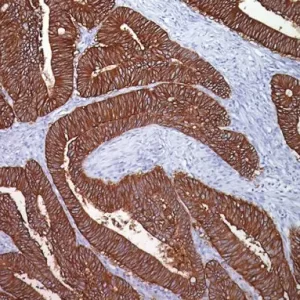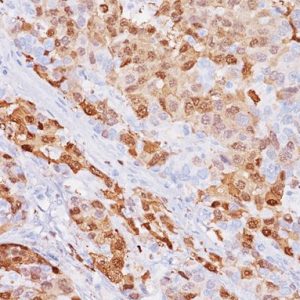Description
Immunoglobulin G (IgG) is an antibody isotype secreted by plasma cells and composed of four peptide chains – two identical heavy chains and two identical light chains arranged in a Y-shape typical of antibody monomers (1). In humans, IgG consists of four subclasses that differ only marginally in their amino acid composition (1). Representing approximately 75% of serum immunoglobulins in humans, IgG is the most abundant antibody isotype found in the circulation (1). Anti-IgG had been proven useful in the assessment of renal biopsies (2), autoimmune disorders (3), in the identification of plasma cell neoplasms (4) and in non-Hodgkin lymphomas (5). The ratio of IgG4+ plasma cells to IgG+ plasma cells has been considered important in making a diagnosis of IgG4-related disorders (6).
SPECIFICATIONS
Specifications
| INTENDED USE | IVD |
|---|---|
| FORMAT | Concentrate, Predilute |
| VOLUME | 0.1 ml, 0.5 ml, 6.0 ml |
| CLONE | RWP49 |
| ISOTYPE | IgG1 |
| SOURCE | Mouse Monoclonal |
| BY LETTER | H |
DATASHEETS & SDS
REFERENCES
1. Junqueira LC, Carneiro J. Basic Histology. McGraw-Hill, 2003.
2. Shi S, et al. Immunohistochemistry of deparaffinized sections using antigen retrieval with microwave combined pressure cooking versus immunofluorescence in the assessment of human renal biopsies. J Clin Pathol. 2013;66:374-80.
3. Abe K, et al. The utility of IgG, IgM, and CD138 immunohistochemistry in the evaluation of autoimmune liver diseases. Med Mol Morphol. 2014;47:162-8.
4. MaKenna RW, et al. Plasma cell neoplasms. WHO classification of tumours of hematopoietic and lymphoid tissues. 2008, 200-13.
5. Lindemalm C, et al. Prognostic significance of immunoglobulin isotype expression in B-cell non-Hodgkin’s lymphoma. Med Oncol Tumor Pharmacother. 1988;5:243-8.
6. Sepehr A, et al. IgG4+ to IgG+ plasma cells ratio of ampulla can help differentiate autoimmune pancreatitis from other “mass forming” pancreatic lesions. Am J Surg Pathol. 2008;32:1770-9.
7. Center for Disease Control Manual. Guide: Safety Management, NO. CDC-22, Atlanta, GA. April 30, 1976 “Decontamination of Laboratory Sink Drains to Remove Azide Salts.”
8. Clinical and Laboratory Standards Institute (CLSI). Protection of Laboratory Workers from Occupationally Acquired Infections; Approved Guideline-Fourth Edition CLSI document M29-A4 Wayne, PA 2014. Page







Reviews
There are no reviews yet.